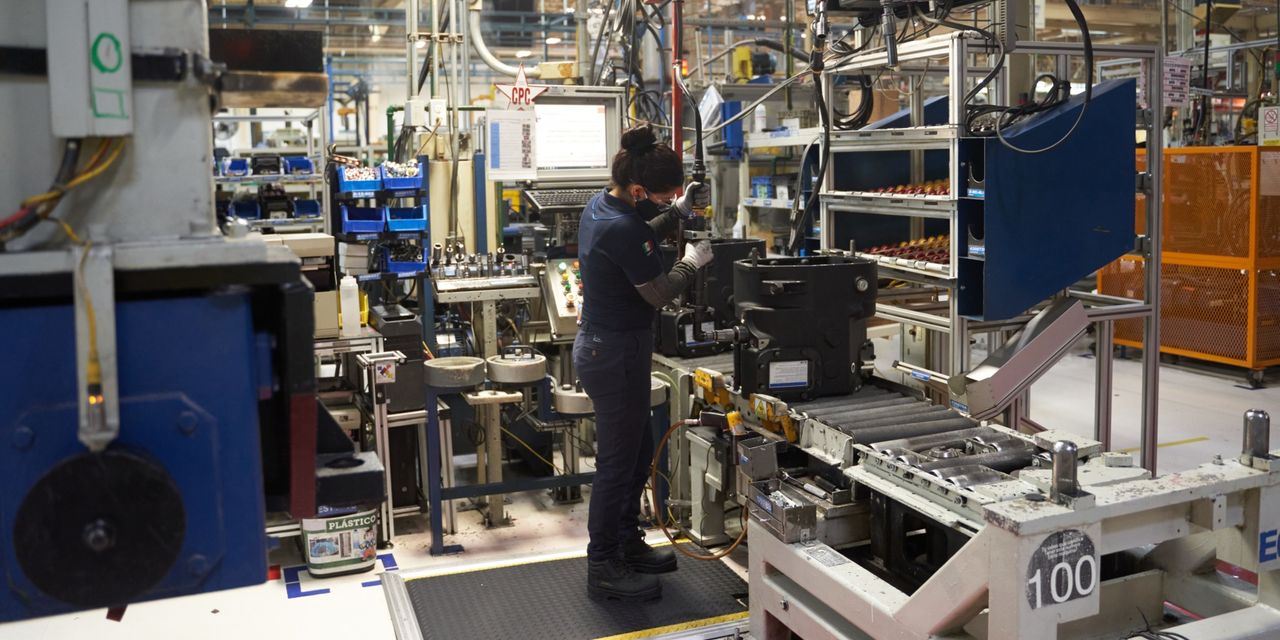Wall Street loves spotting new themes for stock buyers, but many fizzle. Three years ago, investment bankers marveled over TAMs—total addressable markets—for meatless burgers and big-screen exercise machines. Since then, Beyond Meat and Peloton Interactive have each fallen over 85%.
About the same time—after the pandemic toilet-paper shortage had eased, but before the everything-else shortage had begun—there was talk of reshoring, and onshoring, and back-shoring, and all the other terms for bringing more manufacturing home to America. Skepticism was high, because the idea wasn’t new. A 2016 industry paper titled “Reshoring: Myth or Reality?” found that despite an eight-year surge in media mentions of reshoring, evidence for it was “limited and mixed.”
Now there is clearer momentum.
Intel
(ticker: INTC),
General Motors
(GM),
U.S. Steel
(X),
Eli Lilly
(LLY), and others are building big U.S. factories. Last year, U.S. construction spending on manufacturing hit a record $122 billion. Over the past two years, the U.S. attracted 24% of the world’s foreign direct investment, eight points higher than prior decade levels.
The pandemic highlighted the true costs of outsourcing, which UBS industrial analyst Chris Snyder says weren’t fully appreciated before. “If you asked a company in 2015, 2018, ‘What’s the true cost of outsourcing?’ they would have told you about the working capital,” he says. “‘Well, I guess we have to hold more inventory because there’s more in transit.’”
But outsourcing costs now include sales and market share lost to supply-chain disruptions. Companies are factoring in those costs, along with perks embedded in 2022’s Inflation Reduction Act and Chips and Science Act. Meanwhile, technology is replacing workers, who have grown pricier worldwide. “The benefits of labor are in structural decline,” says Snyder. “I can’t tell you the rate at which labor is going to go away, but if you look at any five- or 10-year increment, the world will be less reliant on labor than previously.”
This is less ominous than it sounds for U.S. workers, because a rebound in manufacturing can help offset the falling number of workers per unit of output. Estimating the size of that rebound is difficult. In 1999, before China joined the World Trade Organization, the U.S. made 27% of the world’s goods. That’s now down to 16%. UBS sees a path back to 20% by 2040. That would mean 5% yearly manufacturing growth, more than double the average of the past two decades.
It would also mean vast new investment. UBS reckons the U.S. underspent by $5 trillion on domestic factories and equipment over the past 20 years.
Don’t picture factories across Asia suddenly closing and relocating to Tennessee. Companies are more likely to look to the U.S. for incremental manufacturing. To predict which industries will come, look for ones that are growing. Other factors include low labor density, healthy U.S. demand for goods, and lots of policy support. Chips, vehicles, and drugs check the boxes. Less-unionized regions like the Southeast, Texas, and the Midwest will probably continue leading in factory growth.
There will be setbacks.
Taiwan Semiconductor Manufacturing
(TSM) said this past week that a new Arizona chip factory will be delayed from late 2024 into 2025 due in part to difficulty finding workers with the right skills. Near term, the company will shift workers from Taiwan. Long term, chips themselves are part of a technology “one-way street,” as UBS puts it, that will continue favoring capital investment and American factories.
Among listed companies, obvious beneficiaries include smart-factory specialists
Rockwell Automation
(ROK) and
Emerson Electric
(EMR). Snyder’s top reshoring pick is
Eaton
(ETN), which makes electrical systems and thus has a hand in factory construction, equipment installation, data centers, and more. Other well-positioned companies include
Trane Technologies
(TT), which makes air-conditioning systems;
Amphenol
(APH) for sensors and other electronic doodads;
Keysight Technologies
(KEYS) for test equipment and software; and
W.W. Grainger
(GWW) for industrial supplies.
Some of these stocks are already up a lot and look pricey. In 2015, I wrote that Eaton shares at 13 times earnings had a big dividend and potential for a double-digit percentage gain. Quaint times: The stock is up 300% since then, to a recent 25 times earnings, and the yield has been squeezed to 1.6%. Earnings growth is pegged at over 10% annually for three years.
Several industrial names will report quarterly results at the end of July and in early August. Snyder says that investors don’t yet fully appreciate the strength and durability of the reshoring movement, and that estimates for Eaton and others will have to move “materially higher.” We’ll see soon.
Bonding Opportunity
Disney World in Florida has two water parks, and one of them, Blizzard Beach, has something called Summit Plummet—said to be the world’s fastest free-fall slide. I tried it four years ago, and the experience was so invasive that it should have come with a copayment. I’m reminded of it when I look at Treasury yields. Investors typically get higher ones for locking in longer maturities. Occasionally, the yield curve slopes gently downward, like, say, the kiddie slides at Blizzard Beach’s Tike’s Peak play area. But the curve recently hit its steepest inversion in more than four decades, which is enough to make bond buyers shift in their seats.
What to do? Lock in 5.4% on the short stuff, or go out to 10 years for 3.9%? The answer might seem obvious, but Schwab’s chief fixed-income strategist Kathy Jones says too many bond investors are staying short. “What an inverted yield curve tells you is the market is expecting rates to be lower in the future,” she says. To extend maturities without sacrificing too much income, look to high-grade corporate bonds, which pay 5% to 5.5%. The
Schwab 5-10 Year Corporate Bond
exchange-traded fund (SCHI) yields 5.3%.
Plummet averted.
Write to Jack Hough at [email protected]. Follow him on Twitter and subscribe to his Barron’s Streetwise podcast.
Read the full article here





